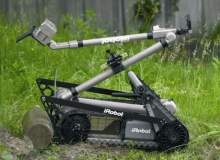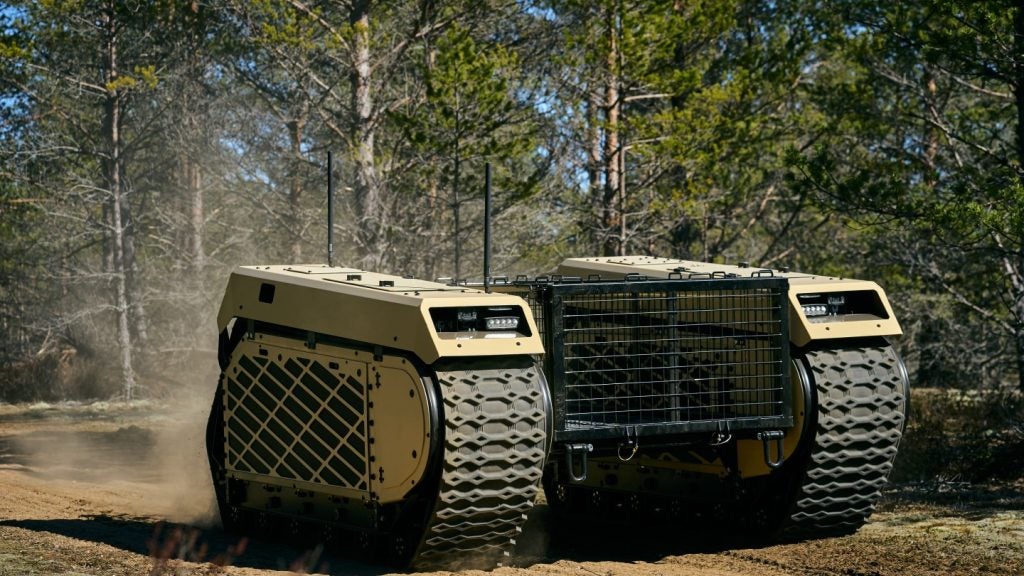
Conflicts in Afghanistan and Iraq, almost typified by the increased risk of IEDs to soldiers on patrol, have led to a dramatic rise in the number of missions carried out by military robots.
Fitted with a vast array of attachments and accessories, today’s battle bots are capable of carrying out a range of missions, ranging from reconnaissance to ordnance disposal, without putting a soldier’s life at risk.
While the Wheelbarrow may have set the example for ordnance disposal robots, the likes of the PackBot and TALON have revolutionised how military robots are perceived, leading to an unprecedented increase in robot development, epitomised by the wide range of robots that can have a direct impact in-theatre today.
PackBot 510, from iRobot
The PackBot 510, developed by iRobot, is arguably the most renowned battlefield robot and one of the most successful battle-tested robots in the world. Its various variants and accessories, that can be added and removed in order to tailor the PackBot to individual tasks or missions, have provided PackBot users with a comprehensive solution to a number of battlefield scenarios.
The first PackBots were developed by iRobot in 1997 using a grant from the US Government, before a number of prototypes were sent to Afghanistan in late 2002. The sweeping success and popularity of the robot progressed into further development of the PackBot.
A decade later, current PackBot 510 variants include an EOD Bomb Disposal Kit, a light-weight fast tactical maneuvering kit designed for use with infantry troops carrying out IED inspections, a first responder kit for use by first responders for situational awareness and a HazMat Detection Kit, fitted with sensors to detect the presence of chemical and biological agents.
How well do you really know your competitors?
Access the most comprehensive Company Profiles on the market, powered by GlobalData. Save hours of research. Gain competitive edge.

Thank you!
Your download email will arrive shortly
Not ready to buy yet? Download a free sample
We are confident about the unique quality of our Company Profiles. However, we want you to make the most beneficial decision for your business, so we offer a free sample that you can download by submitting the below form
By GlobalDataMore than 2,000 machines are currently in service in Iraq and Afghanistan, and the robots were the first to enter Fukushima nuclear power plant following the 2011 earthquake and tsunami. More than 4,000 PackBots have been delivered to military and civil defence forces worldwide, fulfilling a range of roles too dangerous for a soldier to carry out.
TALON, by QinetiQ
The TALON, originally developed by Foster-Miller prior to the company’s acquisition by QinetiQ, is a small, tracked military robot designed to fulfil missions including reconnaissance and combat.
Controlled through a two-way radio or fiber-optic link from an Operator Control Unit, it is principally equipped with a robotic manipulator, used in explosive ordnance disposal missions. Other versions of the TALON have also been equipped with day / night colour cameras for reconnaissance and sensors to detect chemical, gas, temperature and radiation for HAZMAT requirements.
The TALON special weapons observation reconnaissance detection system (SWORDS) variation is weaponised and can be equipped with a range of weapons, including an M16 rifle, M240 machine gun, M82 Barrett rifle or a 40mm grenade launcher. Although deployed in Iraq in 2007, weapons have remained unused and following a cut in US Army funding its successor, the modular advanced armed robotic systems (MAARS), is currently under development by QinetiQ.
The TALON has been in use since 2000 and has seen action in Bosnia and Iraq, while also being used in Special Forces missions in Afghanistan. Perhaps most notably, these robots were used on the scene at Ground Zero after the September 11 2001 terrorist attacks in New York, helping search for victims buried under the rubble.
More than 3,000 TALON robots have been delivered to date, boasting more than 20,000 successful EOD missions in Iraq and Afghanistan.
Wheelbarrow bomb disposal robot
All military and civil defence bomb disposal robots owe their legacy to the grandfather of them all, the Wheelbarrow.
In its original incarnation, the Wheelbarrow was designed for the British Army by Lieutenant-Commander Peter Miller in 1972 to address the terrorist bomb threat in Northern Ireland. Developed from a prototype made from a wheelbarrow and a lawnmower, the robot carried out bomb disposal by remote control at a stand-off distance.
The Wheelbarrow is still in production, now made by Northrop Grumman‘s Remotec division, which is the sole supplier to the UK Ministry of Defence for this size of robot. The latest version, Wheelbarrow Mk9, was launched in 2010 with a range of upgrades. These include digital communications for improved quality and greater security, plus an enhanced man-machine interface enabling it to be controlled via touch-screen facility and joystick, or a wireless hand controller for local remote control.
Capable of climbing a 45-degree stairway, it has a modular telescopic arm with seven-degrees of freedom and a maximum reach of more than 6m, can reach a speed of 5km / hour and lift 150kg.
On its launch, Kevin Rooney, managing director Unmanned Ground Vehicles for Northrop Grumman’s Information Systems sector in Europe, said: “This latest design of our well proven Wheelbarrow vehicle combines greater speed, mobility, exceptional payload and reach capabilities with the latest control, communications and camera specifications to offer unsurpassed performance.”
ReconRobotics Recon Scout XT
Bringing robots right up to date, armed services worldwide are concentrating on the smaller end of the scale, with a vision of every foot soldier carrying a thowable micro-robot in their pack to provide surveillance and in some cases help disarm bombs.
The US Army has thrown its weight firmly behind the Recon Scout XT from ReconRobotics, having recently issued a contract for $13.9m for 1,100 more robot kits, plus another $1m for accessories, its biggest micro-robot order to date.
Weighing just 544g, the Recon Scout XT can be easily thrown over a wall, into a room or down a roadside culvert to reveal the position of enemies or hidden bombs. A video feed is displayed on a handheld operator control unit that can also be used to control it from a stand-off distance of up to 91 metres outdoors, although it can also be used at short range attached to a SearchStick.
Sturdy enough to be dropped from an unmanned aerial vehicle (UAV), the robot avoids detection in low-light conditions by automatically switching on infrared optical systems to operate in darkness.
Cobham tEODor
In August 2011, the Spanish Armed Forces showed its satisfaction with Cobham‘s telerob Explosive Ordnance Disposal (EOD) robot tEODor, by ordering a further three units, bringing its fleet to 27 systems in total, the fourth largest in the world. This finalised a ten-year programme to replace older equipment for remotely rendering explosive devices safe.
A heavy duty EOD robot with a long pedigree, tEODor remains an industry leader, deployed in 41 countries by the military and civil security operators.
The basic system is equipped with a two-camera vision system with variable lighting. Quickly deployed and operated from a control station with a large TFT monitor, it has its own power supple and can be set up quickly.
It has interchangeable tools and comes with a magazine for up to three alternative tools from a selection of 40, including a shooting system that can be exchanged remotely without having to return to the operator.





